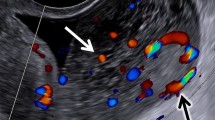Abstract
Purpose
Torsion angle determines the incidence of necrosis among patients with ovarian torsion. The purpose of this study was to evaluate the association between torsion angle and findings on CT scan.
Materials and methods
We retrospectively reviewed CT scan findings obtained less than 36 h before surgery for 31 patients with ovarian torsion. Ovarian torsion angles measured intraoperatively ranged from 90° to 1260°. Ovaries with torsion angles less than 360° rarely develop necrosis. Patients were divided into two groups according to torsion angle: <360° (Group A) and ≥360° (Group B). A lesion corresponding to an enlarged fallopian tube and mesovarium containing dilated veins between the uterus and twisted ovary is referred to as a “mass-like swelling”.
Results
A mass-like swelling occurred more often in Group B (p < 0.05) and had the highest correlation with torsion angles ≥360°. A mass-like swelling lacking enhancement or a high-density area was significantly different between the groups (p < 0.05) and was also indicative of torsion angles ≥360°.
Conclusion
A mass-like swelling alone or with a high-density area or lack of enhancement suggests an ovarian torsion angle ≥360°. The presence of these findings predict ovarian necrosis and may allow ovary-sparing treatment.





Similar content being viewed by others
References
Hibbard LT. Adnexal torsion. Am J Obstet Gynecol. 1985;152:456–61.
Nichols DH, Julian PJ. Torsion of the adnexa. Clin Obstet Gynecol. 1985;28:375–80.
Tobiume T, Shiota M, Umemoto M, Kotani Y, Hoshiai H. Predictive factors for ovarian necrosis in torsion of ovarian tumor. Tohoku J Exp Med. 2011;225:211–4.
Zweizing S, Perron J, Grubb D, Mishell DR Jr. Conservative management of adnexal torsion. Am J Obstet Gynecol. 1993;168:1791–5.
Shalev J, Mashiach R, Bar-Hava I, Girtler O, Bar J, Dicker D, et al. Subtorsion of the ovary: sonographic features and clinical management. J Ultrasound Med. 2001;20:849–54.
Swenson DW, Lourenco AP, Beaudoin FL, Grand DJ, Killelea AG, McGregor AJ. Ovarian torsion: case-control study comparing the sensitivity and specificity of ultrasonography and computed tomography for diagnosis in the emergency department. Eur J Radiol. 2014;83:733–8.
Duigenan S, Oliva E, Lee SI. Ovarian torsion: diagnostic features on CT and MRI with pathologic correlation. AJR Am J Roentgenol. 2012;198:122–31.
Kimura I, Togashi K, Kawakami S, Takakura K, Mori T, Konishi J. Ovarian torsion: cT and MR imaging appearances. Radiology. 1994;190:337–41.
Rha SE, Byun JY, Jung SE, Jung JI, Choi BG, Kim BS, et al. CT and MR imaging features of adnexal torsion. Radiographics. 2002;22:283–94.
Lee JH, Park SB, Shin SH, Jang JC, Lee WC, Jeong AK, et al. Value of intra-adnexal and extra-adnexal computed tomographic imaging features diagnosing torsion of adnexal tumor. J Comput Assist Tomogr. 2009;33:872–6.
Lubner M, Menias C, Rucker C, Bhalla S, Peterson CM, Wang L, et al. Blood in the belly: CT findings of hemoperitoneum. Radiographics. 2007;27:109–25.
Parizel PM, Makkat S, Van Miert E, Van Goethem JW, van den Hauwe L, De Schepper AM. Intracranial hemorrhage: principles of CT and MRI interpretation. Eur Radiol. 2001;11:1770–83.
Schultz LR, Newton WA Jr, Clatworthy HW Jr. Torsion of previously normal tube and ovary in children. N Engl J Med. 1963;268:343–6.
Taskin O, Birincioglu M, Aydin A, Buhur A, Burak F, Yilmaz I, et al. The effects of twisted ischaemic adnexa managed by detorsion on ovarian viability and histology: an ischaemia-reperfusion rodent model. Hum Reprod. 1998;13:2823–7.
Conflict of interest
The authors declare that they have no conflict of interest.
Author information
Authors and Affiliations
Corresponding author
About this article
Cite this article
Ito, K., Utano, K., Kanazawa, H. et al. CT prediction of the degree of ovarian torsion. Jpn J Radiol 33, 487–493 (2015). https://doi.org/10.1007/s11604-015-0452-z
Received:
Accepted:
Published:
Issue Date:
DOI: https://doi.org/10.1007/s11604-015-0452-z




